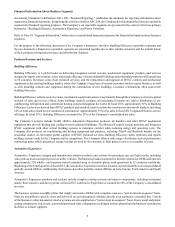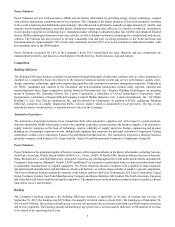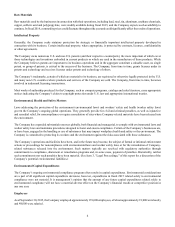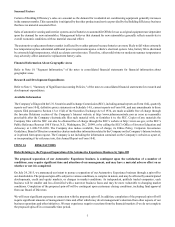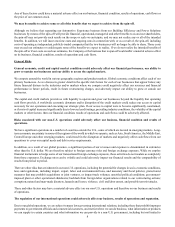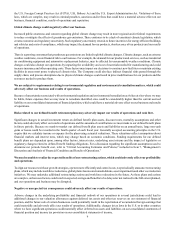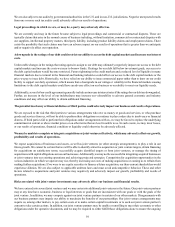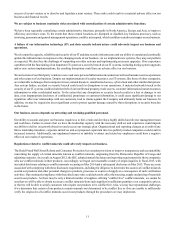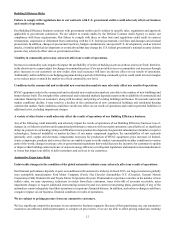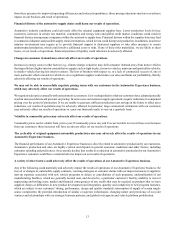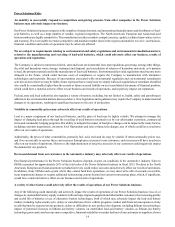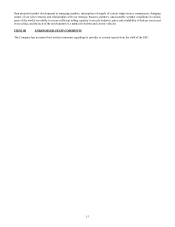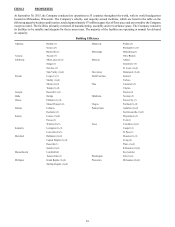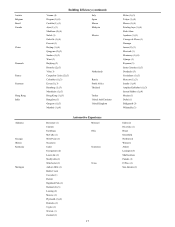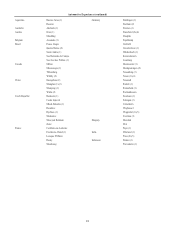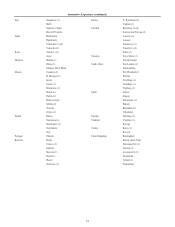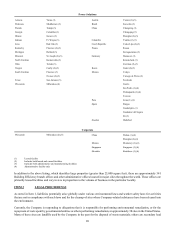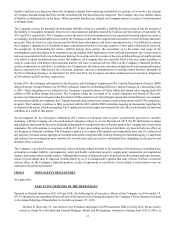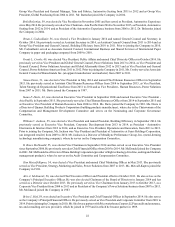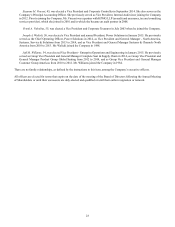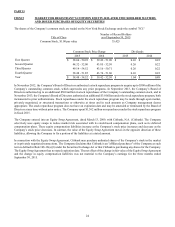Johnson Controls 2015 Annual Report Download - page 14
Download and view the complete annual report
Please find page 14 of the 2015 Johnson Controls annual report below. You can navigate through the pages in the report by either clicking on the pages listed below, or by using the keyword search tool below to find specific information within the annual report.
14
Power Solutions Risks
An inability to successfully respond to competition and pricing pressure from other companies in the Power Solutions
business may adversely impact our business.
Our Power Solutions business competes with a number of major domestic and international manufacturers and distributors of lead-
acid batteries, as well as a large number of smaller, regional competitors. The North American, European and Asian lead-acid
battery markets are highly competitive. The manufacturers in these markets compete on price, quality, technical innovation, service
and warranty. If we are unable to remain competitive and maintain market share in the regions and markets we serve, our business,
financial condition and results of operations may be adversely affected.
We are subject to requirements relating to environmental and safety regulations and environmental remediation matters,
related to the manufacturing and recycling of lead-acid batteries, which could adversely affect our business, results of
operation and reputation.
The Company is subject to numerous federal, state and local environmental laws and regulations governing, among other things,
the solid and hazardous waste storage, treatment and disposal, and remediation of releases of hazardous materials; as it pertains
to lead, the primary material used in the manufacture of lead-acid batteries. Environmental laws and regulations may become more
stringent in the future, which could increase costs of compliance or require the Company to manufacture with alternative
technologies and materials. Because of uncertainties associated with environmental regulation and environmental remediation
activities at sites where we may be liable, future expenses that we may incur to comply with such regulations or remediate identified
sites could be considerably higher than the current or future accrued liability on our consolidated statements of financial position,
which could have a material adverse effect on our business and results of operations, and negatively impact our reputation.
Federal, state and local authorities also regulate a variety of matters, including, but not limited to, health, safety and permitting in
addition to the environmental matters discussed above. New legislation and regulations may require the Company to make material
changes to its operations, resulting in significant increases to the cost of production.
Volatility in commodity prices may adversely affect our results of operations.
Lead is a major component of our lead-acid batteries, and the price of lead may be highly volatile. We attempt to manage the
impact of changing lead prices through the recycling of used batteries returned to us by our aftermarket customers, commercial
terms and commodity hedging programs. Our ability to mitigate the impact of lead price changes can be impacted by many factors,
including customer negotiations, inventory level fluctuations and sales volume/mix changes, any of which could have an adverse
effect on our results of operations.
Additionally, the prices of other commodities, primarily fuel, acid, resin and tin, may be volatile. If other commodity prices rise,
and if we are not able to recover these cost increases through price increases to our customers, such increases will have an adverse
effect on our results of operations. Moreover, the implementation of any price increases to our customers could negatively impact
the demand for our products.
Decreased demand from our customers in the automotive industry may adversely affect our results of operations.
Our financial performance in the Power Solutions business depends, in part, on conditions in the automotive industry. Sales to
OEMs accounted for approximately 26% of the total sales of the Power Solutions business in fiscal 2015. Declines in the North
American, European and Asian automotive production levels could reduce our sales and adversely affect our results of operations.
In addition, if any OEMs reach a point where they cannot fund their operations, we may incur write-offs of accounts receivable,
incur impairment charges or require additional restructuring actions beyond our current restructuring plans, which, if significant,
would have a material adverse effect on our business and results of operations.
A variety of other factors could adversely affect the results of operations of our Power Solutions business.
Any of the following could materially and adversely impact the results of operations of our Power Solutions business: loss of, or
changes in, automobile battery supply contracts with our large original equipment and aftermarket customers; the increasing quality
and useful life of batteries or use of alternative battery technologies, both of which may adversely impact the lead-acid battery
market, including replacement cycle; delays or cancellations of new vehicle programs; market and financial consequences of any
recalls that may be required on our products; delays or difficulties in new product development, including lithium-ion technology;
impact of potential increases in lithium-ion battery volumes on established lead-acid battery volumes as lithium-ion battery
technology grows and costs become more competitive; financial instability or market declines of our customers or suppliers; slower


